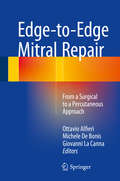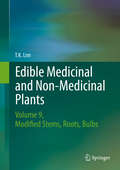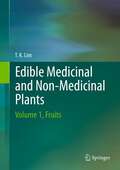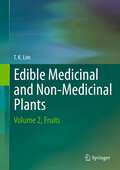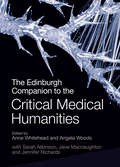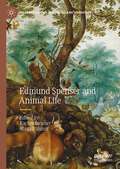- Table View
- List View
The Edge of Life: Human Dignity and Contemporary Bioethics (Philosophy and Medicine #85)
by Christopher KaczorThe Edge of Life: Human Dignity and Contemporary Bioethics treats a number of distinct moral questions and ?nds their answer in the dignity of the person, both as an agent and as a patient (in the sense of the recipient of action). Characteristically one’s view of the human being ultimately shapes one’s outlook on these matters. This book addresses questions that divide a culture of life from a culture of death as well as a number of questions debated within the Catholic tradition itself. The Edge of Life offers a critique of the new bio-ethic, represented by such notable authors as Peter Singer; it also attempts to shore up some of the dif?culties leveled by critics against the traditional ethic as well as to answer some questions disputed by those within the tradition. This book does not treat the basic principles of morality but rather many of their applications and suppositions. (For an account of contemporary debates within the Catholic tradition on these matters, see Kaczor 2002). Rather, The Edge of Life seeks to address a number of disputed contemporary questions touching upon human dignity at what has been called “the margins of life. ” The ?rst section of the book treats the dignity of the human person as recipient of action and as agent. Chapter two examines various accounts of when a human being becomes a person.
The Edge of Medicine: Stories of Dying Children and Their Parents
by David J. BearisonThe Edge of Medicine tells the stories of dying children and their families, capturing the full range of uncertainties, hopes and disappointments, and ups and downs of children near the end of life. Dr. Bearison relies on narrative to bridge the disconnect among abstract theories, medical technologies, and clinical realities.
Edge-to-Edge Mitral Repair: From a Surgical to a Percutaneous Approach
by Ottavio Alfieri Michele De Bonis Giovanni La CannaThis is the first comprehensive review of the edge-to-edge technique for mitral repair, which was introduced into the surgical armamentarium in 1991 by one of the authors, Ottavio Alfieri. The surgical technique employed in edge-to-edge repair today provides the basis for the only reliable method of percutaneous correction of degenerative mitral regurgitation. The book traces the evolution of the edge-to-edge technique from a surgical to a percutaneous approach, documenting indications, contraindications, technical aspects, controversies and clinical outcomes. Detailed attention is devoted to the MitraClip procedure, which reproduces the Alfieri stitch percutaneously and has to date been used in more than 20,000 patients worldwide. The state of the art in MitraClip therapy is described, with clear explanation of when and how to use the MitraClip system. The reader will learn all aspects of percutaneous edge-to-edge repair, which is recommended for use in carefully selected patients in the new ESC/EACTS guidelines for the management of valvular heart disease and in the ESC guidelines on heart failure. The group at San Raffaele Hospital, Milan, has accumulated by far the largest experience in the world with the technique and over the years has been very active in its promotion and scientific evaluation. This book reflects that depth of knowledge and will be of great interest to cardiac surgeons and interventional and clinical cardiologists.
Edhf 2002
by Paul M. VanhoutteUnderstanding the nature and role of endothelium-derived hyperpolarizing factor is crucial in the quest for improved treatments for hypertension, diabetes, ischemia-reperfusion, and other vascular disorders. EDHF 2002 is based on the proceedings of the Fourth International Symposium on endothelium-dependent hyperpolarizations. It will be of interest not only to physiologists and pharmacologists puzzled by the complexity of the interactions between the endothelium and underlying vascular smooth muscle cells, but also clinical researchers and physicians treating patients with cardiovascular diseases.
Edible and Medicinal Mushrooms of the Himalayas: Climate Change, Critically Endangered Species, and the Call for Sustainable Development (Natural Products Chemistry of Global Plants)
by Ajay Sharma Garima Bhardwaj Gulzar Ahmad NayikThis book, as part of the “Natural Products Chemistry of Global Plants” series, describes in detail the health-promoting wild edible and medicinal mushrooms specific to the Himalayas region. The focus of the book is to draw on the rich culture, folklore, and environment of the Upper Himalayas, which represents a scientifically significant region. The Himalayas has rich plant resources and a large diversity of plants and mushrooms, which can provide important health benefits as detailed throughout the text. Drawing attention to these mushrooms with detailed scientific descriptions may help in the awareness and in developing sustainable growth of these important resources. Features Provides an opportunity to describe the wild edible and medicinal mushrooms from this scientifically significant region. Represents a wider variety of mushrooms than previously published in other books. Presents more content related to traditional uses, phytochemistry, pharmacology, distribution, processing, toxicology, conservation, and future prospective of individual mushrooms. The plants and mushrooms of the region are valuable resources not only to local populations but to those living outside the region. Scientists are monitoring the rich Himalayan plant resources and the consequences of climate change on this precarious ecosystem.
Edible and Medicinal Mushrooms of the Himalayas: Climate Change, Critically Endangered Species, and the Call for Sustainable Development (Natural Products Chemistry of Global Plants)
This book, as part of the “Natural Products Chemistry of Global Plants” series, describes in detail the health-promoting wild edible and medicinal mushrooms specific to the Himalayas region. The focus of the book is to draw on the rich culture, folklore, and environment of the Upper Himalayas, which represents a scientifically significant region. The Himalayas has rich plant resources and a large diversity of plants and mushrooms, which can provide important health benefits as detailed throughout the text. Drawing attention to these mushrooms with detailed scientific descriptions may help in the awareness and in developing sustainable growth of these important resources. Features Provides an opportunity to describe the wild edible and medicinal mushrooms from this scientifically significant region. Represents a wider variety of mushrooms than previously published in other books. Presents more content related to traditional uses, phytochemistry, pharmacology, distribution, processing, toxicology, conservation, and future prospective of individual mushrooms. The plants and mushrooms of the region are valuable resources not only to local populations but to those living outside the region. Scientists are monitoring the rich Himalayan plant resources and the consequences of climate change on this precarious ecosystem.
Edible Medicinal and Non-Medicinal Plants: Volume 11 Modified Stems, Roots, Bulbs
by T. K. LimThis book covers such plants with edible modified storage subterranean stems (corms, rhizomes, stem tubers) and unmodified subterranean stem stolons, above ground swollen stems and hypocotyls, storage roots (tap root, lateral roots, root tubers), and bulbs, that are eaten as conventional or functional food as vegetables and spices, as herbal teas, and may provide a source of food additive or neutraceuticals. This volume covers selected plant species with edible modified stems, roots and bulbs in the families Iridaceae, Lamiaceae, Marantaceae, Nelumbonaceae, Nyctaginaceae, Nymphaeaceae, Orchidaceae, Oxalidaceae, Piperaceae, Poaceae, Rubiaceae and Simaroubaceae. The edible species dealt with in this work include wild and underutilized crops and also common and widely grown ornamentals.To help in identification of the plant and edible parts coloured illustrations are included. As in the preceding ten volumes, topics covered include: taxonomy (botanical name and synonyms); common English and vernacular names; origin and distribution; agro-ecological requirements; edible plant parts and uses; plant botany; nutritive, medicinal and pharmacological properties with up-to-date research findings; traditional medicinal uses; other non-edible uses; and selected/cited references for further reading. This volume has separate indices for scientific and common names; and separate scientific and medical glossaries.
Edible Medicinal and Non-Medicinal Plants: Volume 12 Modified Stems, Roots, Bulbs
by T. K. LimThis book covers such plants with edible modified storage subterranean stems (corms, rhizomes, stem tubers) and unmodified subterranean stem stolons, above ground swollen stems and hypocotyls, storage roots (tap root, lateral roots, root tubers), and bulbs, that are eaten as conventional or functional food as vegetables and spices, as herbal teas, and may provide a source of food additive or neutraceuticals. This volume covers selected plant species with edible modified stems, roots and bulbs in the families Iridaceae, Lamiaceae, Marantaceae, Nelumbonaceae, Nyctaginaceae, Nymphaeaceae, Orchidaceae, Oxalidaceae, Piperaceae, Poaceae, Rubiaceae and Simaroubaceae. The edible species dealt with in this work include wild and underutilized crops and also common and widely grown ornamentals. To help in identification of the plant and edible parts coloured illustrations are included.As in the preceding ten volumes, topics covered include: taxonomy (botanical name and synonyms); common English and vernacular names; origin and distribution; agro-ecological requirementsedible plant parts and uses; plant botany; nutritive, medicinal and pharmacological properties with up-to-date research findings; traditional medicinal uses; other non-edible uses; and selected/cited references for further reading. This volume has separate indices for scientific and common names; and separate scientific and medical glossaries.
Edible Medicinal And Non-Medicinal Plants: Volume 7, Flowers
by T. K. LimThis book continues as volume 7 of a multi-compendium on Edible Medicinal and Non-Medicinal Plants. It covers plant species with edible flowers from families Acanthaceae to Facaceae in a tabular form and seventy five selected species from Amaryllidaceae, Apocynaceae, Asclepiadaceae, Asparagaceae, Asteraceae, Balsaminaceae, Begoniaceae, Bignoniaceae, Brassicaceae, Cactaceae, Calophyllaceae, Caprifoliaceae, Caryophyllaceae, Combretaceae, Convolvulaceae, Costaceae, Doryanthaceae and Fabaceae in detail. This work will be of significant interest to scientists, medical practitioners, pharmacologists, ethnobotanists, horticulturists, food nutritionists, botanists, agriculturists, conservationists, lecturers, students and the general public. Topics covered include: taxonomy; common/English and vernacular names; origin and distribution; agroecology; edible plant parts and uses; botany; nutritive/pharmacological properties, medicinal uses, nonedible uses; and selected references.
Edible Medicinal and Non Medicinal Plants: Volume 8, Flowers
by T. K. LimVolume 8 is part of a multicompendium Edible Medicinal and Non-Medicinal Plants, on plants with edible flowers from Geraniaceae to Zingiberaceae (tabular) and 82 species in Geraniaceae, Iridaceae, Lamiaceae, Liliaceae, Limnocharitaceae, Magnoliaceae, Malvaceae, Meliaceae, Myrtaceae, Nyctaginaceae, Nymphaeaceae, Oleaceae, Onagraceae, Orchidaceae, Paeoniaceae, Papaveraceae, Plantaginaceae, Poaceae, Polygonaceae, Primulaceae, Proteaceae, Ranunculaceae, Rosaceae, Rubiaceae, Rutaceae, Solanaceae, Theaceae, Tropaeolaceae, Tyhpaceae, Violaceae, Xanthorrhoeaceae and Zingiberaceae in detail. This work is of significant interest to medical practitioners, pharmacologists, ethnobotanists, horticulturists, food nutritionists, botanists, agriculturists, conservationists and general public. Topics covered include: taxonomy; common/ vernacular names; origin/ distribution; agroecology; edible plant parts/uses; botany; nutritive/medicinal properties, nonedible uses and selected references.
Edible Medicinal and Non Medicinal Plants: Volume 9, Modified Stems, Roots, Bulbs
by T. K. LimVolume 9 is part of a multicompendium Edible Medicinal and Non-Medicinal Plants, on plants with edible modified stems, roots and bulbs from Acanthaceae to Zygophyllaceae (tabular) and 32 selected species in Alismataceae, Amaryllidaceae, Apiaceae, Araceae, Araliaceae, Asparagaceae, Asteraceae, Basellaceae, Brassicaceae and Campanulaceae in detail. This work is of significant interest to medical practitioners, pharmacologists, ethnobotanists, horticulturists, food nutritionists, botanists, agriculturists, conservationists, and general public. Topics covered include: taxonomy; common/ vernacular names; origin/ distribution; agroecology; edible plant parts/uses; botany; nutritive/medicinal properties, nonedible uses and selected references.
Edible Medicinal And Non-Medicinal Plants: Volume 6, Fruits
by T. K. LimThis book continues as volume 6 of a multi-compendium on Edible Medicinal and Non-Medicinal Plants. It covers edible fruits/seeds used fresh, cooked or processed into other by-products, or as vegetables, cereals, spices, stimulant, edible oils and beverages. It covers selected species from the following families: Sapindaceae, Sapotaceae, Schisandraceae, Solanaceae, Thymelaeaceae, Urticaceae, Vitaceae and Winteraceae. This work will be of significant interest to scientists, researchers, medical practitioners, pharmacologists, ethnobotanists, horticulturists, food nutritionists, agriculturists, botanists, conservationists, lecturers, students and the general public. Topics covered include: taxonomy; common/English and vernacular names; origin and distribution; agroecology; edible plant parts and uses; botany; nutritive and pharmacological properties, medicinal uses and research findings; nonedible uses; and selected references.
Edible Medicinal And Non-Medicinal Plants: Volume 4, Fruits
by T. K. LimThis book continues as volume 4 of a multi-compendium on Edible Medicinal and Non-Medicinal Plants. It covers edible fruits/seeds used fresh or processed, as vegetables, spices, stimulants, edible oils and beverages. It encompasses selected species from the following families: Fagaceae, Grossulariaceae, Hypoxidaxeae, Myrsinaceae Olacaceae, Oleaceae, Orchidaceae, Oxalidaceae, Pandanaceae, Passifloraceae, Pedaliaceae, Phyllanthaceae, Pinaceae, Piperaceae, Rosaceae and Rutaceae . This work will be of significant interest to scientists, researchers, medical practitioners, pharmacologists, ethnobotanists, horticulturists, food nutritionists, agriculturists, botanists, conservationists, lecturers, students and the general public. Topics covered include: taxonomy; common/English and vernacular names; origin and distribution; agroecology; edible plant parts and uses; botany; nutritive and pharmacological properties, medicinal uses and research findings; nonedible uses; and selected references.
Edible Medicinal And Non-Medicinal Plants: Volume 5, Fruits
by T. K. LimThis book continues as volume 5 of a multicompendium on Edible Medicinal and Non-Medicinal Plants. It covers edible fruits/seeds used fresh, cooked or processed as vegetables, cereals, spices, stimulant, edible oils and beverages. It covers selected species from the following families: Apiaceae, Brassicaceae, Chenopodiaceae, Cunoniaceae, Lythraceae, Papaveraceae, Poaceae, Polygalaceae, Polygonaceae, Proteaceae, Ranunculaceae, Rhamnaceae, Rubiaceae, Salicaceae, Santalaceae, Xanthorrhoeaceae and Zingiberaceae. This work will be of significant interest to scientists, medical practitioners, pharmacologists, ethnobotanists, horticulturists, food nutritionists, botanists, agriculturists, conservationists, lecturers, students and the general public. Topics covered include: taxonomy; common/English and vernacular names; origin and distribution; agroecology; edible plant parts and uses; botany; nutritive/pharmacological properties, medicinal uses, nonedible uses; and selected references.
Edible Medicinal and Non-Medicinal Plants: Volume 1, Fruits
by Lim T. K.This multi-compendium is a comprehensive, illustrated and scientifically up-to-date work covering more than a thousand species of edible medicinal and non-medicinal plants. This work will be of significant interest to scientists, researchers, medical practitioners, pharmacologists, ethnobotanists, horticulturists, food nutritionists, agriculturists, botanists, herbalogists, conservationists, teachers, lecturers, students and the general public. Topics covered include: taxonomy (botanical name and synonyms); common English and vernacular names; origin and distribution; agro-ecological requirements; edible plant part and uses; botany; nutritive and medicinal/pharmacological properties, medicinal uses and current research findings; non-edible uses; and selected/cited references. Each volume covers about a hundred species arranged according to families and species. Each volume has separate scientific and common names indices and separate scientific and medical glossaries.
Edible Medicinal And Non-Medicinal Plants: Volume 2, Fruits
by Lim T. K.This book continues as volume 2 of a multi-compendium on Edible Medicinal and Non-Medicinal Plants. It covers edible fruits/seeds used fresh or processed, as vegetables, spices, stimulants, pulses, edible oils and beverages. It encompasses species from the following families: Clusiaceae, Combretaceae, Cucurbitaceae, Dilleniaceae, Ebenaceae, Euphorbiaceae, Ericaceae and Fabaceae. This work will be of significant interest to scientists, researchers, medical practitioners, pharmacologists, ethnobotanists, horticulturists, food nutritionists, agriculturists, botanists, herbalogists, conservationists, teachers, lecturers, students and the general public. Topics covered include: taxonomy (botanical name and synonyms); common English and vernacular names; origin and distribution; agro-ecological requirements; edible plant part and uses; botany; nutritive and medicinal/pharmacological properties, medicinal uses and current research findings; non-edible uses; and selected/cited references.
Edible Medicinal And Non Medicinal Plants: Volume 3, Fruits
by Lim T. K.This book continues as volume 3 of a multi-compendium on Edible Medicinal and Non-Medicinal Plants. It covers edible fruits/seeds used fresh or processed, as vegetables, spices, stimulants, edible oils and beverages. It encompasses species from the following families: Ginkgoaceae, Gnetaceae, Juglandaceae, Lauraceae, Lecythidaceae, Magnoliaceae, Malpighiaceae, Malvaceae, Marantaceae, Meliaceae, Moraceae, Moringaceae, Muntigiaceae, Musaceae, Myristicaceae and Myrtaceae. This work will be of significant interest to scientists, researchers, medical practitioners, pharmacologists, ethnobotanists, horticulturists, food nutritionists, agriculturists, botanists, conservationists, lecturers, students and the general public. Topics covered include: taxonomy; common/English and vernacular names; origin and distribution; agroecology; edible plant parts and uses; botany; nutritive and pharmacological properties, medicinal uses and research findings; nonedible uses; and selected references.
Edible Plants in Health and Diseases: Volume II : Phytochemical and Pharmacological Properties
by Mubashir Hussain Masoodi Muneeb U RehmanThe book provides essential information on some of the promising edible medicinal plants and how these possess both nutritional as well as therapeutic value. The significance of the edible plants in traditional medicine and the importance of the distribution of their chemical constituents are discussed systematically concerning the role of these plants in ethnomedicine in different regions of the world. The current volume deals with the individual plants' phytochemical and pharmacological properties, emphasizing human health. The title would demonstrate the value of natural edible plants and introduce readers to state-of-the-art developments and trends in omics-driven research. This book is a single-source scientific reference to explore the specific factors that contribute to these potential health benefits and discuss how to maximize those potential benefits. Chemists, food technologists, pharmacologists, phytochemists, and all professionals involved with quality control and standardization will find in this book a valuable and updated basis for their work.
Edible Plants in Health and Diseases: Volume 1 : Cultural, Practical and Economic Value
by Mubashir Hussain Masoodi Muneeb U RehmanThe book provides significant information on some of the promising edible medicinal plants and how these possess both nutritive as well as medicinal value. The significance of these edible plants in traditional medicine, their distribution in different regions and the importance of their chemical constituents are discussed systematically concerning the role of these plants in ethnomedicine in different regions of the world. The current volume focuses on the economic and culturally important medicinal uses of edible plants and a detailed survey of the literature on scientific researches of pharmacognostical characteristics, traditional uses, scientific validation, and phytochemical composition, and pharmacological activities. This book is a single-source scientific reference to explore the specific factors that contribute to these potential health benefits, as well as discussing how to maximize those potential benefits. Chemists, food technologists, pharmacologists, phytochemists as well as all professionals involved with quality control and standardization will find in this book a valuable and updated basis for their work.
The Edinburgh Companion To The Critical Medical Humanities (Edinburgh Companions To Literature )
by Anne Whitehead Angela Woods Sarah Atkinson Jane Macnaughton Jennifer RichardsIn this landmark Companion, expert contributors from around the world map out the field of the critical medical humanities. This is the first volume to comprehensively introduce the ways in which interdisciplinary thinking across the humanities and social sciences might contribute to, critique and develop medical understanding of the human individually and collectively. The thirty-six newly commissioned chapters range widely within and across disciplinary fields, always alert to the intersections between medicine, as broadly defined, and critical thinking. Each chapter offers suggestions for further reading on the issues raised, and each section concludes with an Afterword, written by a leading critic, outlining future possibilities for cutting-edge work in this area.
The Edinburgh Companion to the Critical Medical Humanities (Edinburgh Companions To Literature )
by Anne Whitehead Angela Woods Sarah Atkinson Jane Macnaughton Jennifer RichardsIn this landmark Companion, expert contributors from around the world map out the field of the critical medical humanities. This is the first volume to comprehensively introduce the ways in which interdisciplinary thinking across the humanities and social sciences might contribute to, critique and develop medical understanding of the human individually and collectively. The thirty-six newly commissioned chapters range widely within and across disciplinary fields, always alert to the intersections between medicine, as broadly defined, and critical thinking. Each chapter offers suggestions for further reading on the issues raised, and each section concludes with an Afterword, written by a leading critic, outlining future possibilities for cutting-edge work in this area.
EDiR - The Essential Guide
by Judith Babar Oğuz Dicle Hildo J. Lamb Laura Oleaga Fermín SáezThis EDiR guide has a practical rather than a theoretical focus, and is intended as a reference tool for potential EDiR candidates who would like to gain a better understanding of the EDiR examination. A pool of experts has made every possible effort to create a single source that contains everything needed to successfully pass the EDiR examination. Times have changed, and there is certainly a new generation of radiologists who will find this cutting-edge tool a “must-have” to familiarize themselves with the examination quickly and easily. The book is divided into the following main sections: one chapter for each subspecialty; one chapter on Safety, Management and Imaging Procedures; another on Principles of Imaging Techniques and Processing; and lastly, one on Management. This structure follows the same pattern as the EDiR examination, which is based on the European Training Curriculum (ETC) for Radiology released by the European Society of Radiology (ESR). Each subspecialty is covered using the same basic structure: Multiple Response Questions (MRQs), Short Cases (SCs) and CORE Cases from one of the most recent EDiR examinations. Students will thus be able to see all the questions from a recent examination and learn from the answers and comments provided by our pool of experts. Clinical cases as electronic supplementary material complete the book, and links to EDiR preparation sessions are also included, allowing students to improve their knowledge of specific areas.
Edith and Florence Stoney, Sisters in Radiology (Springer Biographies)
by Adrian Thomas Francis DuckThis book explores the lives and achievements of two Irish sisters, Edith and Florence Stoney, who pioneered the use of new electromedical technologies, especially X-rays but also ultraviolet radiation and diathermy. In addition, the narrative follows several intertwined themes as experienced by the sisters during their lifetimes. Their upbringing, influenced by their liberal-minded scientist father, set the tone for both their lives. Irish independence fractured their family heritage. Their professional experiences, fulfilling for Florence as a qualified doctor but often frustrating for Edith as a Cambridge-educated scientist, mirrored those of other aspiring women during this period, when the suffragist movement expanded and women’s lobby groups were formed. World War I created an environment in which their unusual specialist knowledge was widely needed, and the sisters’ war experiences are carefully examined in the book. But ultimately this is the extraordinary story of two independent but closely bonded sisters and their abiding love and support for one another.
Edmund Spenser and Animal Life (Palgrave Studies in Animals and Literature)
by Rachel Stenner Abigail ShinnThis book is the first extended critical study of the early modern poet Edmund Spenser from the perspective of animal studies. With an introduction situating Spenser in current discussions of animal life and literary form, and early modern animal studies, the book proceeds in four sections: “Animals and Cultural Practices”; “Animals, Slavery, and Race”; “Animals in Complaints”; “Readers and Poetics in The Faerie Queene”. Contributors discuss a broad range of Spenser’s work, putting it into dialogue with a number of early modern discourses, including politics, poetics, and natural history.
Edmunds' Pharmacology for the Primary Care Provider - E-Book: Edmunds' Pharmacology for the Primary Care Provider - E-Book
by Constance G Visovsky Cheryl H Zambroski Rebecca M. LutzMaster the pharmacologic principles and drug information you need to safely and effectively prescribe drugs for primary care! Edmunds' Pharmacology for the Primary Care Provider, 5th Edition is written for Nurse Practitioners, other Advanced Practice Nursing prescribers, and Physician Assistants. Unlike other pharmacotherapeutics textbooks, it focuses on the drugs most commonly used in primary care settings. A new chapter format and body-system approach make learning easier, and standardized clinical guidelines ensure best practices in pharmacotherapeutics. Updated and impeccably accurate drug content includes the latest drug classes, specific drugs, and therapeutic uses in primary care. Continuing to emphasize health promotion strategies, this new edition includes new chapters on pharmacogenetics, drugs for ADHD, nutritional supplements, and more. Comprehensive pharmacotherapeutics content is written specifically for Nurse Practitioners, other Advanced Practice Nurses, and Physician Assistants. Focus on key drugs highlights the most commonly prescribed and most representative drugs of each major drug class — with particular emphasis on the top 100 prescribed drugs. Emphasis on patient teaching helps you communicate with patients and family caregivers to promote adherence to the drug regimen. Emphasis on health promotion describes how to help patients stay well and improve their health, including coverage of vitamins, weight management, immunizations and biologicals, and smoking cessation. Complementary and Alternative Therapies tables highlight significant dietary and herbal interactions with FDA-approved drugs.


